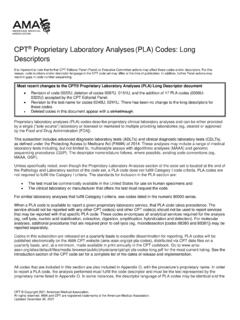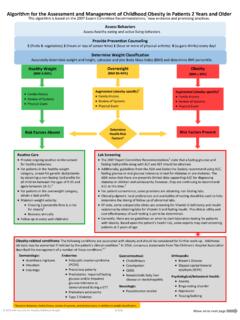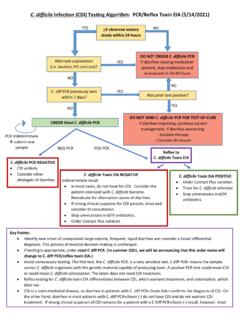Transcription of EXAMPLE Machine Learning Exam questions
1 EXAMPLE Machine Learning (C395) Exam questions (1) Question: Explain the principle of the gradient descent algorithm . Accompany your explanation with a diagram. Explain the use of all the terms and constants that you introduce and comment on the range of values that they can take. Solution: Training can be posed as an optimization problem, in which the goal is to optimize a function (usually to minimize a cost function E) with respect to a number of free variables, usually weights wi. The gradient decent algorithm begins from an initialization of the weights ( a random initialization) and in an iterative procedure updates the weights wi by a quantity wi, where wi = ( E / wi) and ( E / wi) is the gradient of the cost function with respect to the weights, while is a constant which takes small values in order to keep the updates low and avoid oscillations.
2 (2) Question: Derive the gradient descent training rule assuming that the target function representation is: od = w0 + w1x1 + .. + wnxn. Define explicitly the cost/error function E, assuming that a set of training examples D is provided, where each training EXAMPLE d D is associated with the target output td. Solution: The error function: E = d D (td od)2 The gradient decent algorithm : wi = ( E / wi) First represent ( E / wi) in terms of the unit inputs xid, outputs od, and target values td: ( E / wi) = ( d D (td od)2) / wi = d D 2(td od) ( (td od) / wi) = d D 2(td od) ( od / wi) = d D 2(td od) ( (w0 + .. + wixid + .. + wnxnd) / wi) = d D 2(td od) (xid) => wi = d D 2(td od) xid (3) Question: Prove that the LMS training rule performs a gradient descent to minimize the cost/error function E defined in (2).
3 Solution: Given the target function representation od = w0 + w1x1 + .. + wnxn, LMS training rule is a Learning algorithm for choosing the set of weights wi to best fit the set of training examples {< d, td >}, , to minimize the squared error E d D (td od)2. LMS training rule works as follows: ( < d, td >) use the current weights wi to calculate od ( wi) wi wi + (td od)xid (*) From (2) ( E / wi) = d D 2(td od)xid (1/2xid)( E / wi) = (td od) Substitute this in (*) ( wi) wi wi + ( /2)( E / wi) This shows that LMS alters weights in the very same proportion as does the gradient descent algorithm ( , E / wi), proving that LMS performs gradient descent. (4) Question: Consider the following set of training examples: What is the information gain of a2 relative to these training examples?
4 Provide the equation for calculating the information gain as well as the intermediate results. Solution: Entropy E(S) = E([3+, 3-]) = -(3/6) log2 (3/6) - (3/6) log2 (3/6) = 1. Gain (S, a2) = E(S) (4/6)E(T) (2/6)E(F) = 1 4/6 2/6 0. E(T) = E([2+, 2-]) = 1. E(F) = E([1+, 1-]) = 1. (5) Question: Suppose that we want to build a neural network that classifies two dimensional data ( , X = [x1, x2]) into two classes: diamonds and crosses. We have a set of training data that is plotted as follows: Instance Classification a1 a2 1 + T T 2 + T T 3 - T F 4 + F F 5 - F T 6 - F T Draw a network that can solve this classification problem. Justify your choice of the number of nodes and the architecture. Draw the decision boundary that your network can find on the diagram. Solution: A solution is a multilayer FFNN with 2 inputs, one hidden layer with 4 neurons and 1 output layer with 1 neuron.
5 The network should be fully connected, that is there should be connections between all nodes in one layer with all the nodes in the previous (and next) layer. We have to use two inputs because the input data is two dimensional. We use an output layer with one neuron because we have 2 classes. One hidden layer is enough because there is a single compact region that contains the data from the crosses-class and does not contain data from the diamonds-class. This region can have 4 lines as borders, therefore it suffices if there are 4 neurons at the hidden layer. The 4 neurons in the hidden layer describe 4 separating lines and the neuron at the output layer describes the square that is contained between these 4 lines. (6) Question: Suppose that we want to solve the problem of finding out what a good car is by using genetic algorithms.
6 Suppose further that the solution to the problem can be represented by a decision tree as follows: X2 X1 sport engine size brand large small mid no Volvo no BMW SUV no yes V8 no V10 F12 no yes yes no What is the appropriate chromosome design for the given problem? Which genetic algorithm parameters need to be defined? What would be the suitable values of those parameters for the given problem? Provide a short explanation for each. What is the result of applying a single round of the prototypical genetic algorithm ? Explain your answer in a clear and compact manner by providing the pseudo code of the algorithm . Solution: size = {large, mid, small} 100, 010, 001, 011, .., 111, 000 brand = {Volvo, BMW, SUV} 100, 010, 001, 011, .., 111, 000 sport = {yes, no} 10, 01, 11, 00 engine = {F12, V12, V8} 100, 010, 001, 011.
7 , 111, 000 GoodCar = {yes, no} 10, 01, 11, 00 chromosome design: size brand sport engine GoodCar 100 100 11 111 01 Fitness function for the given problem can be defined as a Sigmoid function f(x) = 1 / (1+ e-x), where x is the percentage of all training examples correctly classified by a specific solution (chromosome). Selection method , rank selection method can be used; Crossover technique 2-point crossover can be used for the given problem with a crossover mask 1111110000011; the reason is that either size + brand or sport + engine define the solution Crossover rate usually k = 60% Mutation rate usually 1% Termination condition , all training examples are correctly classified GA pseudo code: Step 1: Choose initial population. Step 2: Evaluate the fitness of individuals in the population.
8 Step 3: Select k individuals to reproduce; breed new generation through crossover and mutation; evaluate the individual fitness of offspring; replace k worse ranked part of population with offspring. Step 4: Repeat step 3 until the termination condition is reached. s1/2: 1010101001010, 1011111110101, 0100011111101, 0011111001010, 1011011110101 s3: 1010101110110 (fit 1), 0011111001001 (fit 0), 1010101111110 (fit 2), 1011011001001 (fit 1), 0011111110101 (fit 2), 1011011110101 (fit 3) result: 1011111110101, 1011011110101, 1011011110101, 0011111110101, 1010101111110






